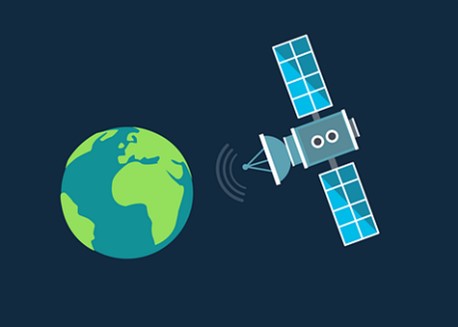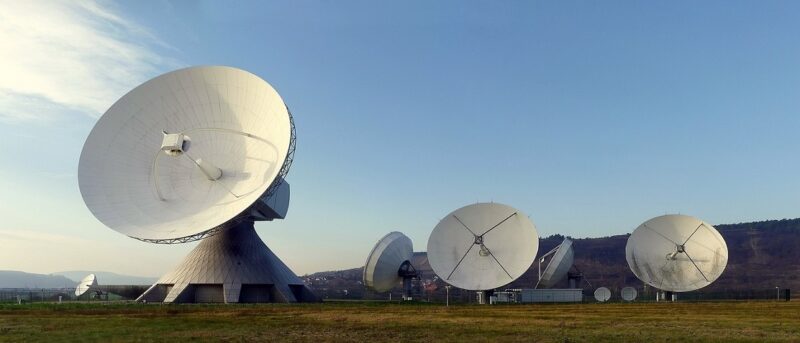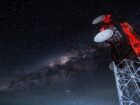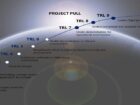Quantum communication systems have revolutionized the security of the encryption keys distribution, thanks to the unique property of having the ability to detect if a third person has tried to obtain the key (eavesdropper’s detectability) and, thus, break the line communication to preserve the message. This method of communication is called Quantum Key Distribution.
As stated in Quantum Key Distribution, secure line communications, a space-based relay quantum communication system, is necessary to transmit quantum keys for distances up to a hundred kilometers.
In this article, we will comment on the proposed architectures of space, ground, and control segments for operational space-based Quantum Key Distribution in the paper “Network Architectures for Space-Optical Quantum Cryptography Services” published in the International Conference on Space Optical Systems and application (ICSOS) 2012.
Architecture based on LEO and GEO satellites
The study mentions three possible scenarios in which a balance between cost and performance is sought to provide ‘information-theoretically’ secure (ITS) critical services to the most significant possible number of users.
Two architectures are proposed, one using LEO satellites and the other using GEO satellites, employing the TESAT Laser Communication Terminal (LCT) to distribute the quantum signals to the ground. In this way, the satellite can send quantum keys to each ground station and thus establish a secure line of quantum communication. In addition, the satellite must be able to distillate keys (post-processing) and a storage stage for the keys. In short, this architecture makes the satellite a trusted repeater node between two terrestrial units, sequentially establishing a key with the satellite to obtain a standard key later.

This system is an analogy of the classic key distribution system used in the cryptographic technique One-time pad (OTP), where a trusted courier handles the transport and security of the keys. In space-based relay quantum communication, the satellite is the trusted actor in charge of distributing the keys and being quantum; it has a higher degree of security since it can be verified if they are secret. Therefore, for this system, it is necessary to have a trusted satellite.
In addition, there is a system in which a trusted satellite is not necessary, called the entanglement double-link system. However, this solution, as the paper said, involves tremendous cost.
Weather conditions for key distribution
Establishing the quantum communication between the ground station and the satellite is recommended in good environmental conditions. keys can be sent anytime, but weather conditions may negatively slow the key rate but do not impede real-time communication.
Key rates, ground terminals, and QKD Services
The study proposes several configurations of ground terminals for each architecture, an estimation of key rates, and calculated cots per user. It also lists the different services that each configuration can provide. In all scenarios, the TESAT Laser Communication Terminal (LCT) is used with a 13.5cm aperture
For LEO-based architecture, stationary and mobile ground stations are proposed:
- Stationary:
- 50cm aperture that can key rates up to 13Mbits per day
- Calculated cost per megabit of user 312€/Mbit
- Examples of possible services mentioned:
- Secure quantum communication between the Government seat and/or Ministry Headquarters.
- Secure communication between command centers and operating centers, submarines, and aircraft carriers.
- Mobile terminals:
- 25 cm aperture that can key rates up to 3Mbits per day
- Calculated cost per megabit of user 77€/Mbit
- Examples of possible services mentioned:
- Database backups of banks, medium and large institutions, and companies such as UBS, Citicorp, Oracle, Google, etc.
- Real-time stock exchange: Sensitive document transmission and authentication of transfers (accountability).
- Supervisory Control and Data Acquisition (SCADA), such as the connections of oil/gas pipelines and nuclear power plants; QKD is used between the control center and the remote installations.
For GEO-based architecture, a stationary ground station is proposed with the following characteristics:
- Stationary:
- 200cm aperture that can key rates up to 39MBits per day
- Calculated cost per megabit of user 615€/Mbit
- Examples of possible services mentioned:
- Secure quantum communication between Foreign Ministry Headquarters and Embassies
- Inter-Governmental Organizations’ (IGO) Headquarters secure communication with their subsidiaries.
- Metropolitan Area QKD Network Interconnect, for example, metropolitan Quantum Key Distribution networks in Europe.
These costs are calculated based on an investment period of 5 years. The study reference is included in the paper.
References: Icsos2012
- Quantum Key Distribution, Secure Line Communications - 10th November 2022
- Space-Based Quantum Communication - 10th November 2022
- Optical Transceiver In New Generation Satellite Communication - 9th November 2022




